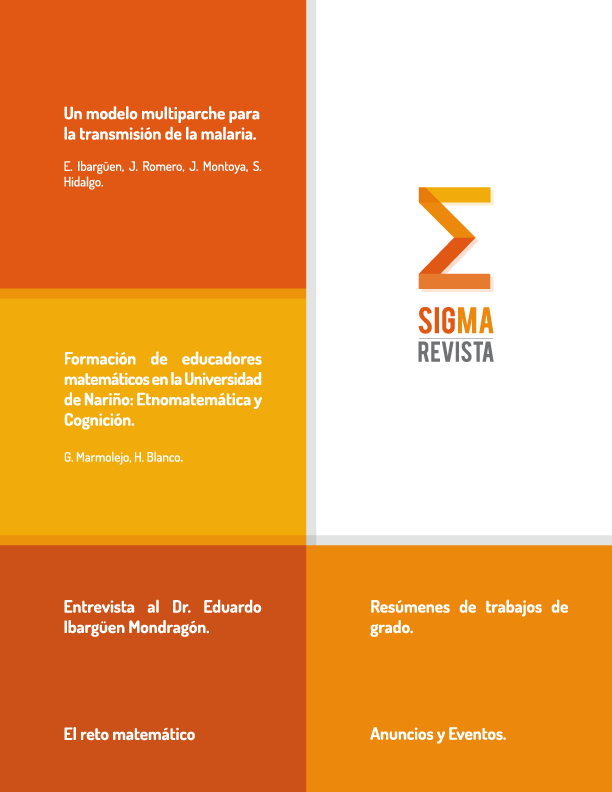Un modelo multiparche para la transmisión de la malaria
Palabras clave:
Modelos Matemáticos, Tuberculosis, Estabilidad, Inmunología, Innata, Soluciones de equilibrio, Estabilidad OrbitalResumen
Resumen.
En este trabajo se formula y analiza un modelo multiparche para epidemiologa de la malaria que
considera transmision vertical y crecimiento percapita de los individuos susceptibles. Los resultados
sugieren uns dinamica muy diferente a los modelos clasicos los cuales presentan bifurcaciones hacia
adelante o hacia atras
Abstract.
In this paper is formulated and analyzed a multipatch model for malaria epidemiology
considering vertical transmission and percapita growth of susceptible individuals. The results suggest
a very dierent dynamic to the classical models which has forward or backward bifurcations.
Descargas
Citas
Basa~nez M.G. y Rodriguez D.J., Dinamica de transmision y modelos matematicos en enfermedades
transmitidas por vectores. Entonomia, Vol. 19, No. 3, Diciembre, 2004, pp. 113-134.
R. Ross, The prevention of malaria, John Murray, London, 1911 1
Sobrebon, J; Cocho, G; Aldama, A; Falconi, M; Esteva, L y Lara, M. Clasicos de la Biologa
Matematica. Siglo XXI editores, s.a de c.v. Cerro del agua 248. Delegacion Coyoacan, 04310,
Mexico D.F. Primera edicion (2002) 1
Macdonald G, The epidemiology and control of malaria, Oxford University. Press, London,
2
Dietz K, Molineaux L, Thomas A. A malaria model tested in the African savannah. Bull World
Health Organ. 50(3-4):347-357 (1974) 2
Ngwa, G and Shu, W. A Mathematical Model for Endemic Malaria with Variable Human and
Mosquito Populations. Msthematical and Computer Modeling 32 (2000) 747-763 2
Chitnis, N. Using mathematical models in controlling the spread of malaria. In Partial Fulllment
of the Requirements For the Degree of Doctor OF Philosophy In the Graduate College .
University of Arizona (2005). 2
Chitnis, N; Cushing, M and Hyman, J. Bifurcation analysis of a mathematical model for
malaria transmission. Society for Industrial and Applied Mathematics. Vol. 67, No. 1, pp.
-45 (2006) 2
Chitnis, N; Hyman, J and Cushing, M. Determining Important Parameters in the Spread of
Malaria Through the Sensitivity Analysis of a Mathematical Model. Bulletin of Mathematical
Biology (2008) 2
L. Torres-Sorando and D. J. Rodriguez. Models of spatio-temporal dynamics in malaria. Ecol.
Model., 104:231-240, 1997. 2
D. J. Rodriguez and L. Torres-Sorando, Models of infectious diseases in spatially heterogeneous
environments, Bull. Math. Biol., 63 (2001), pp. 547-571. 2
Rainey , J et.al. Spatial distribution of Burkitt's lymphoma in Kenya and association with
malaria risk. Tropical Medicine and International Health. volume 12 no 8 pp 936-943 (2007) 2
C. Dye and G. Hasibeder, Population dynamics of mosquito-borne disease: eects of
ies which
bite some people more frequently than others, Trans. R. Soc. Trop. Med. Hyg., 80 (1986), pp.
-77. 2
G. Hasibeder and C. Dye, Population dynamics of mosquito-borne disease: persistence in a
completely heterogeneous environments, Theoret. Population Biol., 33 (1988), pp. 31-53. 2
D. L. Smith, J. Dusho, and F. E. McKenzie, The risk of a mosquito-borne infection in a
heterogeneous environment, PLoS Biol., 2 (2004), pp. 1957-1964. 2
P. Auger, E. Kouokam, G. Sallet, M. Tchuente, and B. Tsanou, The Ross-Macdonald model
in a patchy environment, Math. Biosci., 216 (2008), pp. 123-131. 2
C. Cosner, J. C. Beier, R. S. Cantrell, D. Impoinvil, L. Kapitanski, M. D. Potts, A. Troyo,
and S. Ruan, The eects of human movement on the persistence of vector-borne diseases, J.
Theoret. Biol., 258 (2009), pp. 550-560. 2
J. Arino, A. Ducrot, and P. Zongo, A metapopulation model for malaria with transmissionblocking
partial immunity in hosts, J. Math. Biol., 64 (2012), pp. 423-448. 2
Gao, D y Ruan, S. A multipatch malaria model with logistic growth populations. SIAM J.
APPL. MATH. c-2012. Vol. 72, No. 3, pp. 819-841 (2012). 2


